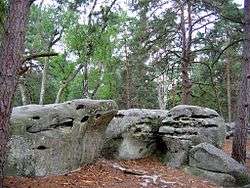Forest of Fontainebleau



The forest of Fontainebleau (French: Forêt de Fontainebleau, or Forêt de Bière, meaning "forest of heather") is a mixed deciduous forest lying sixty kilometres southeast of Paris, France. It is located primarily in the arrondissement of Fontainebleau in the southwestern part of the department of Seine-et-Marne. Most of it also lies in the canton of Fontainebleau, although parts of it extend into adjoining cantons, and even as far west as the town of Milly-la-Forêt in the neighboring department, Essonne. Several communes lie within the forest, notably the towns of Fontainebleau and Avon. The forest has an area of 280 km2 (110 sq mi).
Fauna and flora
The most common trees in the forest are: oak (44%), Scots pine (40%), and European beech (10%). Three thousand species of mushrooms have been discovered. The forest is also home to approximately seven thousand animal species, five thousand of which are insects.
Flowers
- Tor-grass (Brachypodium pinnatum)
- Service tree of Fontainebleau (Sorbus latifolia), which is under national protection
- Snowy mespilus (Amelanchier ovalis), under national protection
- Common juniper (Juniperus communis)
- Orchids
- Violet limodore (Limodorum abortivum)
- Red helleborine (Cephalanthera rubra), under national protection
- Meadow rue (Thalictrum minus), under national protection
- Peach-leaved bellflower (Campanula persicifolia)
- Wild madder (Rubia peregrina)
- Burnet rose (Rosa pimpinellifolia)
- Cranesbill (Geranium sanguineum)
- Vincetoxicum (Vincetoxicum hirundinaria)
- Red feather clover (Trifolium rubens), under national protection
Birds
- Great spotted woodpecker (Dendrocopos major)
- Lesser spotted woodpecker (Dendrocopos minor)
- Great tit (Parus major)
- Blue tit (Parus caeruleus)
- Chiffchaff (Phylloscopus collybita)
- Willow warbler (Phylloscopus trochilus)
- Bonelli's warbler (Phylloscopus bonelli)
- Blackcap (Sylvia atricapilla)
Rock shapes
The place is also known for peculiar rock shapes which resemble elephant, tortoise, crocodile which are believed to be natural formation.[1]
Fictional depictions
- The forest is the main scene of action of the trilogy, Les Fourmis by Bernard Werber.
- In the novel, The Scarlet Pimpernel by Baroness Orczy, Sir Percy and Margeurite St Just wander in this forest during the happy period of their courtship
- Act I (the prologue in the Italian version) of Verdi's opera, Don Carlos, is set in the forest of Fontainebleau.
- Chapter 6 of the ground-breaking film serial Les Vampires takes place in Fontainebleau Forest.
- The map "Castle Rock" in the game Alliance of Valiant Arms takes place in the Fontainebleau Forest.
- The Santalune Forest location in Pokémon X and Y is based loosely on Fontainebleau Forest.
 Python Crushing a Gnu. Setting is the Forest of Fontainebleau. The Walters Art Museum.
Python Crushing a Gnu. Setting is the Forest of Fontainebleau. The Walters Art Museum.
See also
References
- ↑ "Strange Rocks At Fontainebleau". Retrieved 22 March 2015.
External links
-
 Media related to Forest of Fontainebleau at Wikimedia Commons
Media related to Forest of Fontainebleau at Wikimedia Commons - Fontainebleau, forêt d'émotions Official webpage from Office National des Forêts (in French)
Coordinates: 48°25′N 2°40′E / 48.417°N 2.667°E